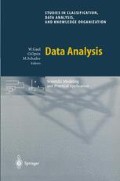Abstract
Order-constrained dissimilarity matrices (e.g., Robinson, strongly-Robinson, ultrametric matrices) are generally used as clustering models to fit the best hierarchical classification to the observed dissimilarity matrix, by minimizing a loss function, e.g. the least-squares criterion. Generally, a similar strategy has not being directly considered for non-hierarchical cluster analysis. In this paper such classifications are represented as order-constrained distance matrices with at most two off-main diagonal positive entries. Several bijections between non-hierarchical clustering structures and order-constrained distance matrices are established.
Access this chapter
Tax calculation will be finalised at checkout
Purchases are for personal use only
Preview
Unable to display preview. Download preview PDF.
References
CRITCHLEY, F. and FICHET, B. (1994): The partial order by inclusion of the principal classes of dissimilarity on a finite set, and some of their basic properties. In: B. Van Cutsem (Ed.): Classification and Dissimilarity Analysis, Lecture Notes in Statistics, Springer-Verlag, 5–65.
CRITCHLEY, F. and VAN CUTSEM, B. (1994): An order-theoretic unification and generalisation of certain fundamental bijections in mathematical classification. I and II. In: B. Van Cutsem (Ed.): Classification and Dissimilarity Analysis, Lecture Notes in Statistics, Springer-Verlag, 87–147.
DIDAY, E. (1984): Une représentation visuelle des classes empiétantes: les pyramides. Rapport de recherche n. 29, INRIA Rocquencourt, France.
DIDAY, E. (1986): Nouvelle représentations graphiques en classification automatique. Rapport de recherche n. 569, INRIA Rocquencourt, France.
FICHET, B. (1984): Sur une extension de la notion de hiérarchie et son équivalence avec certaines matrices de Robinson. Journées de Statistique, Montpellier, France.
JOHNSON, S. C. (1967): Hierarchical clustering schemes. Psychometrika, 32, 241–253.
LECLERC, B. (1994): The residuation model for the ordinal construction of dissimilarities and other valued objects. In: B. Van Cutsem (Ed.): Classification and Dissimilarity Analysis, Lecture Notes in Statistics, Springer-Verlag, 149–172.
VAN CUTSEM, B. (ed.) (1994): Classification and Dissimilarity Analysis, Lecture Notes in Statistics, Springer-Verlag.
Author information
Authors and Affiliations
Editor information
Editors and Affiliations
Rights and permissions
Copyright information
© 2000 Springer-Verlag Berlin · Heidelberg
About this chapter
Cite this chapter
Vicari, D., Vichi, M. (2000). Non-Hierarchical Classification Structures. In: Gaul, W., Opitz, O., Schader, M. (eds) Data Analysis. Studies in Classification, Data Analysis, and Knowledge Organization. Springer, Berlin, Heidelberg. https://doi.org/10.1007/978-3-642-58250-9_5
Download citation
DOI: https://doi.org/10.1007/978-3-642-58250-9_5
Publisher Name: Springer, Berlin, Heidelberg
Print ISBN: 978-3-540-67731-4
Online ISBN: 978-3-642-58250-9
eBook Packages: Springer Book Archive

